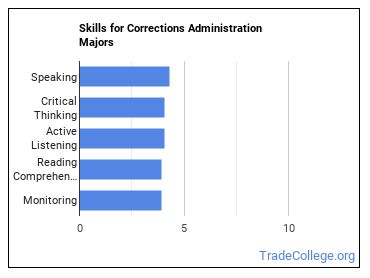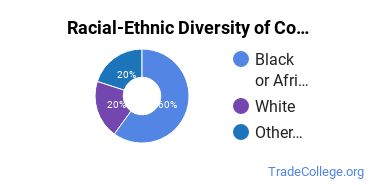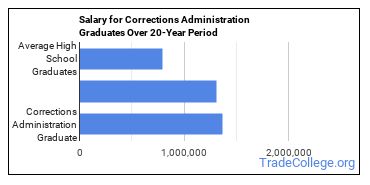Find Trade Colleges
Corrections Administration
Types of Degrees Corrections Administration Majors Are Getting
The following table lists how many corrections administration graduations there were for each degree level during the last year for which data was available.
| Education Level | Number of Grads |
|---|---|
| Bachelor’s Degree | 95 |
| Undergraduate Certificate | 19 |
| Associate Degree | 3 |
| Basic Certificate | 1 |
What Corrections Administration Majors Need to Know
People with careers related to corrections administration were asked what knowledge areas, skills, and abilities were important for their jobs. They weighted these areas on a scale of 1 to 5 with 5 being the highest.
Knowledge Areas for Corrections Administration Majors
This major prepares you for careers in which these knowledge areas are important:

- Public Safety and Security - Knowledge of relevant equipment, policies, procedures, and strategies to promote effective local, state, or national security operations for the protection of people, data, property, and institutions.
- Law and Government - Knowledge of laws, legal codes, court procedures, precedents, government regulations, executive orders, agency rules, and the democratic political process.
- English Language - Knowledge of the structure and content of the English language including the meaning and spelling of words, rules of composition, and grammar.
- Education and Training - Knowledge of principles and methods for curriculum and training design, teaching and instruction for individuals and groups, and the measurement of training effects.
- Administration and Management - Knowledge of business and management principles involved in strategic planning, resource allocation, human resources modeling, leadership technique, production methods, and coordination of people and resources.
Skills for Corrections Administration Majors
The following list of skills has been highlighted as some of the most essential for careers related to corrections administration:

- Speaking - Talking to others to convey information effectively.
- Critical Thinking - Using logic and reasoning to identify the strengths and weaknesses of alternative solutions, conclusions or approaches to problems.
- Active Listening - Giving full attention to what other people are saying, taking time to understand the points being made, asking questions as appropriate, and not interrupting at inappropriate times.
- Reading Comprehension - Understanding written sentences and paragraphs in work related documents.
- Monitoring - Monitoring/Assessing performance of yourself, other individuals, or organizations to make improvements or take corrective action.
Abilities for Corrections Administration Majors
As a corrections administration major, you will find yourself needing the following abilities:

- Oral Expression - The ability to communicate information and ideas in speaking so others will understand.
- Oral Comprehension - The ability to listen to and understand information and ideas presented through spoken words and sentences.
- Written Comprehension - The ability to read and understand information and ideas presented in writing.
- Inductive Reasoning - The ability to combine pieces of information to form general rules or conclusions (includes finding a relationship among seemingly unrelated events).
- Written Expression - The ability to communicate information and ideas in writing so others will understand.
Who Is Getting an Associate’s Degree in Corrections Administration?
Racial-Ethnic Diversity
At the countrywide level, the racial-ethnic distribution of corrections administration majors is as follows:

| Race/Ethnicity | Number of Grads |
|---|---|
| Asian | 0 |
| Black or African American | 2 |
| Hispanic or Latino | 1 |
| White | 0 |
| International Students | 0 |
| Other Races/Ethnicities | 0 |
How Much Do Corrections Administration Majors Make?
Salaries According to BLS
Corrections Administration majors often go into careers where salaries can range from $68,350 to $72,390 (25th to 75th percentile). This range includes all degree levels, so you may expect those with a more advanced degree to make more while those with less advanced degrees will typically make less.
To put that into context, according to BLS data from the first quarter of 2020, the typical high school graduate makes between $30,000 and $57,900 a year (25th through 75th percentile). The average person with a bachelor’s degree (any field) makes between $45,600 and $99,000. Advanced degree holders make the most with salaries between $55,600 and $125,400.
Amount of Education Required for Careers Related to Corrections Administration
Some careers associated with corrections administration require an advanced degree while some may not even require a bachelor’s. Whatever the case may be, pursuing more education usually means that more career options will be available to you.
Find out what the typical degree level is for corrections administration careers below.

| Education Level | Percentage of Workers |
|---|---|
| High School Diploma - or the equivalent (for example, GED) | 41.1% |
| Post-Secondary Certificate - awarded for training completed after high school (for example, in agriculture or natural resources, computer services, personal or culinary services, engineering technologies, healthcare, construction trades, mechanic and repair technologies, or precision production) | 5.4% |
| Some College Courses | 5.7% |
| Associate’s Degree (or other 2-year degree) | 7.6% |
| Bachelor’s Degree | 4.6% |
| Master’s Degree | 19.3% |
| Post-Master’s Certificate - awarded for completion of an organized program of study; designed for people who have completed a Master’s degree but do not meet the requirements of academic degrees at the doctoral level. | 4.3% |
| First Professional Degree - awarded for completion of a program that: requires at least 2 years of college work before entrance into the program, includes a total of at least 6 academic years of work to complete, and provides all remaining academic requirements to begin practice in a profession. | 0.8% |
| Doctoral Degree | 12.7% |
Online Corrections Administration Programs
The following table lists the number of programs by degree level, along with how many schools offered online courses in the field.
| Degree Level | Colleges Offering Programs | Colleges Offering Online Classes |
|---|---|---|
| Certificate (Less Than 1 Year) | 0 | 0 |
| Certificate (1-2 years) | 3 | 1 |
| Certificate (2-4 Years) | 0 | 0 |
| Associate’s Degree | 3 | 0 |
| Bachelor’s Degree | 3 | 1 |
| Post-Baccalaureate | 0 | 0 |
| Master’s Degree | 2 | 1 |
| Post-Master’s | 0 | 0 |
| Doctor’s Degree (Research) | 0 | 0 |
| Doctor’s Degree (Professional Practice) | 0 | 0 |
| Doctor’s Degree (Other) | 0 | 0 |
Is a Degree in Corrections Administration Worth It?
The median salary for a corrections administration grad is $68,350 per year. This is based on the weighted average of the most common careers associated with the major.
This is 71% more than the average salary for an individual holding a high school degree. This adds up to a gain of about $569,000 after 20 years!

Explore Major by State
Alabama
California
District of Columbia
Idaho
Kansas
Maryland
Mississippi
Nevada
New York
Oklahoma
South Carolina
Utah
West Virginia
Alaska
Colorado
Florida
Illinois
Kentucky
Massachusetts
Missouri
New Hampshire
North Carolina
Oregon
South Dakota
Vermont
Wisconsin
Trades Related to Corrections Administration
You may also be interested in one of the following majors related to corrections administration.
References
*The racial-ethnic minorities count is calculated by taking the total number of students and subtracting white students, international students, and students whose race/ethnicity was unknown. This number is then divided by the total number of students at the school to obtain the racial-ethnic minorities percentage.
- College Factual
- College Scorecard
- National Center for Education Statistics
- O*NET Online
- U.S. Bureau of Labor Statistics
- Usual Weekly Earnings of Wage and Salary Workers First Quarter 2020
More about our data sources and methodologies.
Featured Schools
 Request Info
Request Info
|
Southern New Hampshire University You have goals. Southern New Hampshire University can help you get there. Whether you need a bachelor's degree to get into a career or want a master's degree to move up in your current career, SNHU has an online program for you. Find your degree from over 200 online programs. Learn More > |
